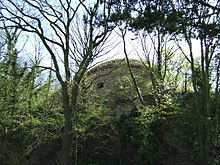Hübeling battery


The Hübeling battery was part of the Prussian fortress of Koblenz and belonged to the system of Feste Kaiser Alexander . The so-called intermediate plant is now in the main cemetery in Koblenz 's Goldgrube district . The battery was built to cover the right flank of the fortress of Emperor Alexander and at the same time secured the blind spot below the fortress . In addition, it dominated the Moselle and the Moseluferstraße as well as the apron of the Moselweißer Schanze (Fort Blücher). Since the 1950s, the Hübeling battery has been a place of honor of the city of Koblenz for those who fell in World War II with a hall of honor.
history
The Hübeling battery was built between 1828 and 1830 as a defensive powder magazine. It was a small detached work with a casemated log house. This consisted of a brick turret with two floors on a hillside, about 350 meters below the fortress of Emperor Alexander. The front side (battery side) is bent to the south, at the back there is the entrance on the first floor (battery level). Access was originally via a movable bridge that was located in the fire area of the throat notches and that was later replaced by a fixed bridge. The log house is surrounded by a walled ditch, the earth cover on the roof is about 2.5 m. It was not intended for a peaceful troop occupation. The front of the basement was designed as a gallery with scrap openings for mortars . The plant with eight to ten armed guns and mortars as well as a detachment of infantry in addition to the artillery crew. In 1859 a water pipe was laid from Saillant IV of the fortress of Emperor Alexander.
The plant was abandoned along with other parts of the fortress in 1903 and leased to the city of Koblenz. After the First World War , the Inter-Allied Military Control Commission waived the demolition because it was no longer of any military use. The Koblenz Entfestungsamt had previously campaigned for the preservation of the facility, among other things by pointing out that in the event of a demolition, the death rest of the neighboring main cemetery would be disturbed.
The facility hit the headlines in 2018 after a homeless man whom it had served as a sleeping place was found murdered there.
Honorary place 1939–1945
The facility was redesigned into a memorial from 1954–1956 according to plans by the garden architect Hans Wilhelm Mutzbauer . The almost completely preserved structure in the west of the main cemetery now houses the memorial for the war dead in the city of Koblenz. Four grave fields with ceramic plates of the fallen are grouped around it in the lawn, with groups of three short-armed crosses in between. From the lower main part of the main cemetery you can reach the place of honor through an archway with a hipped slate roof . The stairs with multiple landings and block steps were made of red sandstone .
A fixed bridge leads to the hall of honor through a sandstone-framed entrance on the west side. Oak leaves and iron crosses are attached to the coffered bronze door . The loopholes were closed with frosted glass panes. The artistic equipment of the hall of honor was carried out by the painter and sculptor Eugen Keller . He created a bronze angel, pointing with one hand to the sky and the other hand to the earth, which was placed in front of the eastern rear wall. The names of those killed in action in Koblenz and victims of the air raids are affixed to the walls , created by Franziska Plate using a fresco technique. A staircase leads to an empty hall in the basement.
Monument protection
The Hübeling battery is a protected cultural monument according to the Monument Protection Act (DSchG) and entered in the list of monuments of the state of Rhineland-Palatinate . It is located in Koblenz-Goldgrube in the main cemetery monument zone .
The Hübeling battery has been part of the Upper Middle Rhine Valley UNESCO World Heritage Site since 2002 .
See also
literature
- Klaus T. Weber (dissertation): The Prussian fortifications of Koblenz (1815–1834) . (Series: Art and Cultural Studies Research) 2003, ISBN 3-89739-340-9
- Marcos, Dieter: Fortress and monument preservation. Contributions to dealing with the built environment, in: New research on the fortress Koblenz and Ehrenbreitstein. Volume 1. Ed. Of castles, palaces, antiquities Rhineland-Palatinate and the German Society for Fortress Research. 2., revised. Ed. - Regensburg: Schnell & Steiner 2005, pp. 157–176, here pp. 168f. ISBN 3-7954-1764-3
- Rüdiger Wischemann: The Koblenz Fortress. From the Roman fort and Prussia's strongest fortress to the largest garrison of the Bundeswehr , Koblenz 1978
- Ulrike Weber (edit.): Cultural monuments in Rhineland-Palatinate. Monument topography Federal Republic of Germany. Volume 3.3: City of Koblenz. Districts. Werner, Worms 2013, ISBN 978-3-88462-345-9 .
Web links
- Hübeling battery in: festung-koblenz.de
Individual evidence
- ↑ Sebastian Eder: Homeless man killed in Koblenz: A city is looking for a murderer Frankfurter Allgemeine Zeitung , March 29, 2018.
- ↑ General Directorate for Cultural Heritage Rhineland-Palatinate (ed.): Informational directory of cultural monuments - district-free city of Koblenz (PDF; 1.5 MB), Koblenz 2013
Coordinates: 50 ° 21 ′ 5.3 " N , 7 ° 34 ′ 20" E
